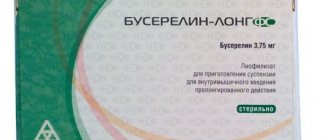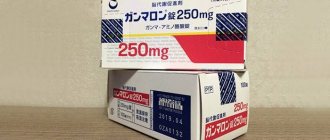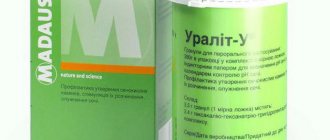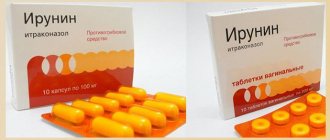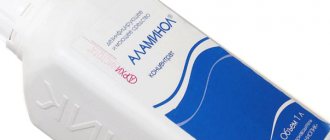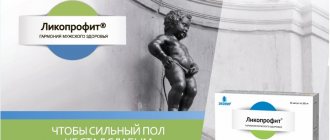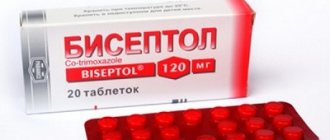When prescribing Natamycin for thrush, the attending physician takes into account its many advantages over other medications. From the extensive group of antimycotic antibiotics, this particular medication is available in different forms, has minimal toxicity and maximum effectiveness against different types of fungi. The ability to practically not cause side effects, as well as the ability to use during pregnancy, make Natamycin the drug of choice in the treatment of fungal infections of variable etiology.
Release form and composition
Natamycin is available in the following dosage forms:
- vaginal suppositories: torpedo-shaped, from light yellow to darker yellow with a light brown tint; there are no foreign inclusions; a funnel-shaped recess or an air rod inside the suppository is allowed (3 pieces each in blister packs, 1 blister pack in a cardboard box and instructions for medical use);
- cream for external and local use: homogeneous, from white to light yellow (5, 10, 15, 20, 25, 30, 35, 40, 50, 60, 70, 80, 90 or 100 g in polymer/glass cans or in aluminum/polymer tubes, in a cardboard pack 1 can or 1 tube and instructions for use of Natamycin).
Composition for 1 suppository:
- active ingredient: natamycin – 100 mg;
- auxiliary components: colloidal silicon dioxide, macrogol glyceryl hydroxystearate, Supposir AM solid fat.
Composition per 1 g of cream for external and local use:
- active ingredient: natamycin – 20 mg;
- auxiliary components: sodium lauryl sulfate, decyl oleate, cetostearyl alcohol, propyl parahydroxybenzoate, cetyl ether wax, methyl parahydroxybenzoate, propylene glycol, purified water.
Natamycin for fungus
The instructions for use of Natamycin contain information that, according to the pharmacological classification, this medicine belongs to antifungal drugs from the group of macrolides, or polyene antibiotics. The active substance of the composition is the component of the same name natamycin (also called pimaricin). This substance:
- penetrates the cells of the pathogen;
- disrupts protein synthesis;
- causes the death of the microorganism.
Composition and release form
Natamycin is available in four forms: suppositories, cream (ointment), tablets and powder substance. Their composition and description are given in the table:
| Vaginal suppositories | Ointment | Pills | Powder | |
| Description | White suppositories in the shape of a torpedo | Homogeneous creamy substance of light yellow color | White round tablets | White homogeneous powder |
| Natamycin concentration, mg | 100 per 1 piece. | 20 per 1 g | 100 per 1 piece. | Pure natamycin |
| Compound | Solid fat, adipic acid, sorbitan trioleate, cetyl alcohol, polysorbate, sodium bicarbonate | Decyloleate, water, cetostearyl alcohol, sodium lauryl sulfate | Potato starch, magnesium stearate, lactose, povidone, calcium carbonate, talc, sucrose | No additional substances |
| Package | 3 pcs. in a strip, 1-2 strips in a pack | Tubes of 30 g | 20 pcs. in a pack | 500 g bottle |
Pharmacodynamics and pharmacokinetics
Natamycin belongs to antibiotics, antimicrobial and antiseptic agents used in gynecology and dermatology. It is effective against pathogenic fungi, including yeast and Candida albican. These pathogens affect the genital tract, but the drug has a fungicidal effect by binding sterols to fungal cell membranes. This breaks the integrity of the shell and kills microorganisms.
According to the instructions, the medication does not have a sensitizing effect and does not cause allergic reactions or resistance. The active substance of the composition acts quickly against fungal infections, relieves inflammation and itching. The tablets are enteric-coated, so they act only in the intestines and do not affect systemic blood flow.
The cream is used externally, suppositories are intended for intravaginal use, so the systemic concentration of natamycin in the blood is also not detectable. Suppositories eliminate heavy vaginal discharge and are evenly distributed throughout all its parts after melting at body temperature. A sufficient amount of the active component is not found in blood and biological fluids, so there is no data on pharmacokinetics.
Indications for use
According to the instructions, the use of Natamycin has certain indications. Common factors for using the drug are:
- vulvovaginous candidiasis, vulvitis, vulvovaginitis;
- vaginitis caused by Candida albicans;
- treatment and prevention of non-invasive intestinal candidiasis;
- fungal infections of the skin and mucous membranes caused by dermatophytes, yeast or yeast-like fungi;
- candidiasis of the mouth, esophagus, digestive tract;
- fungal infections of the feet, legs, torso;
- vaginal candidiasis;
- prevention of primary and secondary infections of skin diseases in immunodeficiency;
- use in ophthalmology for blepharitis, conjunctivitis, keratitis.
Pharmacological properties
Pharmacodynamics
Natamycin is an antifungal polyene antibiotic of the macrolide group. Has a wide spectrum of fungicidal action. The death of microorganisms is caused by the binding of the drug to sterols of cell membranes, as a result of which their integrity and functionality are impaired.
Natamycin is active against the following microorganisms:
- pathogenic yeast-like fungi (especially Candida albicans);
- yeasts (Rhodotorula and Torulopsis);
- other pathogenic fungi (Penicillium and Aspergillus).
The activity of the drug against dermatophytes (Epidermophyton, Microsporum and Trichophyton) is less pronounced.
Under in vitro conditions, natamycin had no effect on gram-negative and gram-positive bacteria. In clinical practice, resistance to the drug was not encountered.
Pharmacokinetics
When used locally and externally, suppositories and cream are almost not absorbed through mucous membranes and intact skin and do not have a systemic effect.
Analogues of Natamycin
On the shelves of pharmacies you can find many drugs similar to Natamycin. They are divided into those that have the same active substance, and those that have a different component composition, but exhibit the same effect. Analogues of Natamycin are as follows:
- Primafungin;
- Pimafucin;
- Natamax;
- Delvocid;
- Ecofucin;
- Vagitsin;
- Dalatsin;
- Clindamycin.
Natamycin, instructions for use: method and dosage
Vaginal suppositories
Natamycin suppositories are intended for vaginal administration.
The suppositories, previously released from the packaging, are inserted as deep as possible into the vagina, 1 piece at a time. once a day (at night). For more convenient administration of the drug, the patient should be in a supine position.
For candidiasis vulvitis, vaginitis and vulvovaginitis, suppositories are used daily for 3-6 days.
The duration of the course is set individually. Treatment should be continued for several more days after the signs of the disease disappear. The administration of Natamycin vaginal suppositories should not be interrupted during menstrual bleeding.
Persistent vaginitis caused by the fungus Candida albicans requires additional systemic treatment. To sanitize the focus of fungal infection in the intestines, the patient is prescribed a tablet form of natamycin (1 tablet four times a day for 10–20 days).
Cream for external and local use
For balanoposthitis, vulvovaginitis and vulvitis, Natamycin cream is applied to the affected areas of the skin and mucous membranes one or several times a day. For persistent diseases caused by the fungus Candida albicans, additional administration of natamycin in the form of suppositories or oral administration in tablet form is recommended.
For dermatomycosis (including diaper rash in children, candidiasis of the nails and skin), the drug is applied to the affected surfaces one to four times a day.
In patients with mycosis of the external auditory canal, the drug is applied to the affected surface (one to four times a day). Before applying Natamycin cream, it is necessary to clean the ear, and after the procedure, place a turunda made of wool, cotton or other natural material into the ear canal.
The duration of the course is set individually. Treatment is continued for some time after the signs of the disease disappear.
If symptoms of infection worsen or do not improve, you should consult your doctor to verify the diagnosis.
Side effects
According to reviews, all Natamycin medications are well tolerated, but the risk of side effects cannot be ruled out. Frequently mentioned factors are:
- allergic reactions, itching, urticaria, skin rash;
- anaphylactic shock, Quincke's edema;
- burning sensation, hyperemia, irritation of mucous membranes and skin;
- vomiting, nausea, dyspepsia, abdominal pain, digestive tract discomfort;
- overdose manifests itself with similar symptoms, its cases are extremely rare, and when it occurs, symptomatic treatment is recommended.
special instructions
After intravaginal administration of the drug, the suppositories turn into a foamy mass under the influence of the patient’s body temperature. This contributes to a more uniform distribution of the active substance throughout the mucous membrane.
During treatment with Natamycin in the form of suppositories, there is no need to exclude sexual intercourse, however, the partner should be examined for the presence of candidiasis infection, and if it is detected, appropriate treatment should be carried out. It is also necessary to use barrier methods of contraception (for example, condoms).
Impact on the ability to drive vehicles and complex mechanisms
The drug does not affect the ability to drive vehicles or operate other complex machinery.
Drug interactions
During treatment with Natamycin, you should not drink alcohol, this leads to hypersensitivity reactions and possible liver dysfunction. It is allowed to combine drugs from the line with each other or combine them with products based on griseovulfine or with antibiotic therapy in complex cases of treatment of dermatomycosis. There are no other data on drug interactions between the drug.
Side effects from taking the drug
It is worth knowing that, despite the effectiveness of Natamycin, its use can lead to side effects. In particular, disorders can arise from the following systems:
- Leather. Allergic reactions in the form of hives, rash, itching, burning and even anaphylactic shock.
- Gastrointestinal organs and dyspeptic disorders. In particular, nausea, vomiting, diarrhea, and pain in the stomach may occur.
- Vaginal disorders. The patient may experience discomfort in the form of redness of the mucous membrane, itching, burning.
- Vestibular apparatus and central nervous system disorders. Dizziness is possible.
Special recommendations for the use of the drug
When treating with Natamycin, you should follow some special recommendations. In particular these:
- Simultaneous use of the drug with alcohol is strictly prohibited. This will at least lead to a decrease in the effectiveness of the drug. At most, the patient may develop the most unexpected reactions.
- During pregnancy, the drug should not be used in the first trimester, as well as after childbirth during lactation.
- When treating thrush in both partners, sexual intercourse cannot be excluded. To prevent re-infection, you can only use barrier contraceptives (condom).
The instructions for use of the drug state that Natamycin (suppositories and cream) should be stored in a cool, dark place. The tablets are also stored in a dark place at a temperature not exceeding +25 degrees. All forms of drugs should be kept out of reach of children. The shelf life of the drug is up to 2 years.
Indications for use
Experts prescribe the drug Natamycin to both female and male patients. The medicine is indicated to be taken and used for the following diseases:
- Patient's oral candidiasis;
- Fungal infections of the digestive tract or esophagus;
- Vaginal fungal pathologies such as vaginitis, vulvovaginitis and vulvitis;
- Fungal pathologies of the intestines;
- Fungus of the hands, feet, body skin, etc.;
- As a prophylactic against possible recurrences of fungal pathology.
Pharmacokinetics
The drug Natamycin, taken in tablets, is not absorbed from the stomach, but works only in the intestines. Also, ointment (gel) and suppositories are not absorbed through the skin and mucous membranes. That is, the drug acts exclusively locally.
Instructions for the use of Taktivin injections and analogues
Important: you should be prepared for the fact that suppositories can form foam when used, which allows you to evenly distribute the components of the drug over the entire surface of the mucous membrane.
Analogues of Natamycin®
The most popular analogue of the original drug is Pimafucin®, produced in the form of suppositories, tablets, and external cream. Its active ingredient is the same antibiotic, so the list of indications, contraindications and methods of use are completely identical. Suppositories based on natamycin® are also available with other trade names:
- Ecofucin®
- Primafungin®
- Natatsin®
Natamycin® can also be replaced with antibiotics of other groups that are effective against fungal diseases. For example, Fluconazole® capsules, suppositories and tablets with Nystatin® and other drugs.
Remedy No. 10
Polygynax
- an antifungal and antibacterial drug, available in the form of vaginal and intravaginal capsules with an emulsion. It is not recommended to use the drug without consulting a doctor during pregnancy and lactation.
Do not forget that all drugs for thrush, despite the fact that they are intended to treat the same disease, have different side effects and contraindications. Therefore, treatment should only be prescribed by a doctor, based on the individuality of the patient.
natamycin during pregnancy
What are GMOs (transgenes)?
Genetically modified organisms (transgenes, GMOs)
– these are organisms (bacteria, plants, animals) into which the genes of other organisms were artificially introduced, in a way impossible in nature. GMOs combine three groups of organisms - genetically modified microorganisms (GMM), animals (GMO) and plants (GMP).
A Brief History of Genetically Modified Organisms
The origins of the development of genetic engineering of plants lie in 1977, when a discovery occurred that made it possible to use the soil microorganism Agrobacterium tumefaciens as a tool for introducing foreign genes into other plants. In 1987, the first field trials of genetically modified crop plants were carried out. The result is a tomato that is resistant to viral infections. In 1992, China began to grow tobacco that was “not afraid” of harmful insects. But the mass production of modified products began in 1994, when tomatoes of the FlavrSavr variety appeared in the United States, which did not spoil during transportation. These are tomatoes with delayed ripening, which are stored for up to six months at a temperature of 14-16 degrees. Ripening occurs when it is placed at room temperature. 1994 is considered the official year of birth of GM products. In 1995, the American giant Monsanto
launched RoundupReady GM soybeans on the market. A foreign gene was introduced into the plant's DNA to increase the crop's ability to resist weeds. As a result, there are now potatoes that contain the genes of an earth bacterium that kills the Colorado potato beetle, drought-resistant wheat in which the scorpion gene was implanted, tomatoes with flounder genes, soybeans and strawberries with bacterial genes. The list of plants grown using genetic engineering methods is very large. It includes: apple tree, plum tree, grapes, cabbage, eggplant, cucumber, wheat, soybean, rice, rye and many other agricultural plants.
What are they needed for? The use of GMOs: pros and cons
The purpose of obtaining genetically modified organisms
– improving the beneficial characteristics of the original donor organism and reducing the cost of products.
Genetically modified organisms have been used in applied medicine since 1982, when human insulin, produced using genetically modified bacteria, was registered as a medicine. Currently, genetically modified organisms are widely used in fundamental and applied scientific research. With the help of GMOs, the patterns of development of certain diseases (Alzheimer's disease, cancer), the processes of aging and regeneration are studied, the functioning of the nervous system is studied, and a number of other pressing problems of biology and medicine are solved. But the most widespread are genetically modified plants. Today they are the ones that cause the most controversy surrounding GMOs. Transgenic plants
produce higher yields, may have new properties, and increased decorative and nutritional value.
GM varieties are resistant to herbicides, unfavorable climates, spoilage during storage, stress, diseases and pests. In addition, familiar products can be endowed with some new properties. For example, decaffeinated coffee, strawberries with less sugar, and rice with higher iron content have been created. Today in the world there are several dozen lines of GM crops: soybeans, potatoes, corn, sugar beets, rice, tomatoes, rapeseed, wheat, melon, chicory, papaya, zucchini, cotton, flax and alfalfa. In 2006, GM crops were grown in 22 countries, including Argentina, Australia, Canada, China, Germany, Colombia, India, Indonesia, Mexico, South Africa, Spain, and the USA. The world's main producers of products containing GMOs are the USA (68%), Argentina (11.8%), Canada (6%), China (3%). In Ukraine, according to the State Committee for Technical Regulation and Consumer Policy, 1 million hectares of fields are sown with genetically modified soybeans, potatoes, corn, and rapeseed, despite the fact that the cultivation of genetically modified plants is prohibited in our country.
Proponents of the use of genetically modified organisms argue that GMOs are the only salvation for humanity from hunger. According to scientists' forecasts, the world's population may reach 9-11 billion people by 2050. Naturally, there is a need to double or even triple global agricultural production. Genetically modified plant varieties are excellent for this purpose - they are resistant to diseases and weather, ripen faster and are stored longer, and are able to independently produce insecticides against pests. GM plants are able to grow and produce good yields where “old” varieties simply could not survive due to certain weather conditions. It would seem that the need to use GMOs is obvious. However, scientists have proven that consuming foods containing GMOs causes: Nutritional risks
• First of all, consuming GM products threatens to weaken the immune system. As a result of the direct action of transgenic proteins, the possibility of allergic reactions arises. The impact of new proteins that produce integrated genes is unknown. The person has never consumed them before and therefore it is unknown whether they are allergens. •Also, humans become resistant to antibiotics, which will make the process of treating many diseases very difficult. Very often, a gene responsible for antibiotic resistance is introduced into a GM plant as a marker gene. Many GM species contain antibiotic resistance genes. If such a resistance gene is transferred to pathogenic bacteria, they will become immune to the action of antibiotics. Thus, treatment with conventional antibiotics becomes less effective. Unfortunately, there are already known cases of people dying for this reason. •Human health is impaired due to the accumulation of herbicides in the body, since GM products tend to accumulate them. •There is a possibility of long-term carcinogenic effects (risk of cancer).
Who would like to completely avoid GMOs?
First of all, it is worth keeping children safe.
Because in a growing organism, GMOs can behave most unpredictably. Secondly, it is better for women planning pregnancy and breastfeeding to do without transgenic products. In addition, people prone to allergies and obesity should be very attentive to the content of GMOs. Environmental risks •There is a real danger of extinction of many plant species, since for genetic modifications they choose literally a couple of varieties and work only with them. •The technology for creating genetically modified products is extremely imperfect, so it is obvious that such products carry an unpredictable danger. In 1998, studies were conducted in the UK on the effect of genetically modified potatoes on human health. In 2003-2004, Italian scientists studied genetically modified soybeans, and in 2005-2006, scientists in Russia did the same. In Australia, genetically modified peas were tested. The results of all studies have shown that GM products have a negative effect on living organisms. •Scientists also draw a direct correlation between the consumption of transgenes and the deterioration of human health in the last ten years (obesity, increase in cancer, various types of allergies). Russian scientist Ermakova I.V. conducted research on the effects of genetically modified soybeans on rats. In the experiment, rats included soy in their daily diet two weeks before mating. As a result, a high mortality rate of rat pups was discovered (more than fifty percent), and the surviving rats no longer reproduced. Negative changes were also noticed in the internal organs of animals. Huge negative changes were also noted in the internal organs of rats. All this gives reason to assume global destruction of the bisophere as a result of infertility in the future. Manufacturers of genetically modified foods claim that no one has ever died from eating such food. This is true - no deaths have yet been recorded as a result of consuming transgenic products. Bye! The fact is that there are no reliable methods for determining the consequences of the spread of GMOs. The many negative effects of GMOs will only appear over generations.
If you read carefully, you will see that all these problems have long manifested themselves and are being discussed from different positions - medical, agricultural, economic. Naturally, no person would want these consequences for themselves and their loved ones, and to do this, it is enough to look carefully at the packaging of the products you buy (today the manufacturer is obliged to provide information about the presence of GMOs in the product they sell) or simply know which products may contain contain GMOs.
Which plants are modified most often?
The most commonly grown GM plants in the world are potatoes, soybeans, corn, rapeseed, tomatoes, zucchini, and rice. But, for example, buckwheat cannot yet be modified. We use GM products not necessarily in their pure form, but often in processed form, in the form of additives - from popcorn, sauces, chips to dumplings, flour, butter.
Where are transgenes more likely to be found?
Currently, 90% of transgenic food exports are corn and soybeans. And if you buy soy products from North America or Argentina, then 80% of them are genetically modified products. In general, the greatest likelihood of encountering GMOs is in the products of large transnational companies, mainly American. There is another pattern that you can indirectly focus on - the more television advertising you see for a product, the more likely it is that it contains GMOs.
Are there GMOs in domestic products? Advice for consumers
According to unofficial information, in Ukraine in 2005, 45% of all soybean crops were genetically modified. According to the magazine “PiK” (February 13-19, 2001), on the state farm “Svitanok” in the Rivne region, GM potatoes of the “New Leaf” variety were grown, after which they were sold to the population. According to the Ministry of Ecological Resources of Ukraine, field tests of GM plants, “KVS”, “Aventis” were also carried out at sites in Berezan (Kiev region), in the village of Dzendzelevtsy (Cherkasy region).
Is it possible to distinguish modified fruits and vegetables from natural ones? Excessively clean potato tubers that differ little from each other or perfectly shaped tomatoes are a reason to think. After all, a sure sign of natural products is the presence in the total mass of “eaten” by insects and rotten specimens. Insects never eat GM products!
If you cut a natural tomato or strawberry, they will immediately give juice; unnatural ones retain their shape. The range of applications of GMOs in food products is quite extensive. These can be meat and confectionery products, which contain soy texture and soy lecithin, as well as fruits and vegetables, such as canned corn. The main flow of genetically modified crops consists of soybeans, corn, potatoes, and rapeseed imported from abroad. They come to our table either in pure form or as additives in meat, fish, bakery and confectionery products, as well as in baby food. For example, if the product contains vegetable protein, then it is most likely soy, and there is a high probability that it is genetically modified. Aspartame, found in carbonated drinks, chewing gum, ketchup, etc., can be produced using GM bacteria and is genetically modified. Unfortunately, it is impossible to determine the presence of GM ingredients by taste and smell; only modern laboratory diagnostic methods can detect GMOs in food products.
The most common GM crops:
Soybeans, corn, rapeseed (canola), tomatoes, potatoes, sugar beets, strawberries, zucchini, papaya, chicory, wheat.
Accordingly, there is a high probability of encountering GMOs in products produced using these plants.
Black list of products in which GMOs are most often used:
GM soybeans
may be included in bread, cookies, baby food, margarine, soups, pizza, fast food, meat products (for example, cooked sausage, sausages, pates), flour, candy, ice cream, chips, chocolate, sauces, soy milk, etc. .d.
GM corn (maize)
May be found in foods such as fast food, soups, sauces, seasonings, chips, gum, and cake mixes.
GM starch
can be found in a very wide range of products, including those that children love, such as yoghurt.
70% of popular baby food brands contain GMOs.
About 30% of coffee on the Ukrainian market is genetically modified. The same situation is with tea.
Genetically modified food additives and flavorings:
E101 and E101A (B2, riboflavin) - added to cereals, soft drinks, baby food, weight loss products. E150 (caramel); E153 (carbonate); E160a (beta-carotene, provitamin A, retinol); E160b (annatto); E160d (lycopene); E234 (lowland); E235 (natamycin); E270 (lactic acid); E300 (vitamin C – ascorbic acid); E301 to E304 (ascorbates); E306 to E309 (tocopherol/vitamin E); E320 (VNA); E321 (VNT); E322 (lecithin); from E325 to E327 (lactates); E330 (citric acid); E415 (xanthine); E459 (beta-cyclodextrin); from E460 to E469 (cellulose); E470 and E570 (salts and fatty acids); fatty acid esters (E471, E472a&b, E473, E475, E476, E479b); E481 (sodium stearoyl-2-lactylate); from E620 to E633 (glutamic acid and glutomates); E626 to E629 (guanylic acid and guanylates); from E630 to E633 (inosinic acid and inosinates); E951 (aspartame); E953 (isomaltite); E957 (thaumatin); E965 (maltinol).
Advice for consumers
By the beginning of this chapter, many readers had made a choice for themselves whether to consume GMO foods or not. For those who decide to take care of themselves, here are some tips. I’ll say right away that GMOs can only be detected in food products in a special laboratory. You can't do this by eye, smell or touch. What should we, the buyers, do? Before going to a store or supermarket, know that 40% of the products sold there contain GMOs. Most GMOs were found in sausages (up to 85%)
, and finding sausages or sausages without transgenes is almost a miracle. Boiled sausages and sausages are especially densely saturated with genetically modified soybeans. By the way, various semi-finished products - dumplings, pasties, pancakes - are also teeming with transgenes. The popular dumplings “Levada” and “Three Bears”, and most sausage producers have been caught using GMOs.
Advice.
Prepare your own meat products!
And not only meat ones! Buy meat at the market and delight your family with goulash, cutlets or home-made pilaf. Or at least don’t eat sausages and sausages regularly! Baby food is in second place in terms of GMO content. 70% of all baby food in Ukraine contains GM components.
Moreover, it is almost impossible to find out that a jar of delicious puree contains a transgene, because it is not written about it on the label. Among the manufacturers who do not disdain the use of GM components are Nestlé and Danone, Similac. So think about whether the famous “Rastishka” is really useful for your baby. But it is children under 4 years of age who are least protected from the effects of transgenes.
Advice.
As terrible as it sounds, try to avoid using baby food.
Breastfeed your baby and pamper him with pureed fruits and vegetables. By the way, any compote is much healthier than “canned” juices. But if you still have to buy cereals and mixtures, avoid the products of the above brands. The third position is for confectionery and bakery products. GM soybeans are generously added to cookies and chocolate, flour, candies and ice cream, and soda.
It is impossible for the average person to identify such supplements. True, bread that does not go stale for a long time contains one hundred percent transgenes. Among the companies exposed by Greenpeace for using GMOs are the famous Mars and Snickers, Cadbury, Coca-Cola, and Pepsi. Of the domestic companies, the confectionery company passed voluntary testing, and only its products bear the green “Does not contain GMOs” badge.
Advice.
80% of American exports contain GMOs, so stop eating products from American companies.
Buy according to the principle - everything that is advertised is not allowed. Nestlé quick breakfasts, nutritious Snickers, Danone yogurts, etc. – all these Greenpeace. Well, the three “leaders” have been identified. But that is not all. 30% of the tea and coffee market contains GMOs.
Transgenic soybeans are successfully used in the production of fast food (McDonald's), condensed milk, ketchup and sauces (Heinz Foods).
Canned corn also raises concerns (choose Hungarian corn - GMOs are prohibited there). In addition, they contain GMOs (according to Greenpeace):
1. Snickers chocolate bars 2. Pepsi 3. Maggi seasonings 4. Pringles chips
And of course vegetables.
It is on vegetables and fruits that I would like to dwell in more detail. You buy them at the market from "grandmothers". Great. But this does not guarantee the absence of transgenes. After all, it is not known what seeds the grandmothers bought. How to distinguish GM products? Firstly, they practically do not spoil and are not of interest to insects. Therefore, buy “bitten” potatoes, which have a variety of sizes. After all, ideal potatoes of the same size are the tricks of geneticists. All GM vegetables are usually stored for a long time (due to the “pasted” genes) and look just perfect. So, avoid glossy, large tomatoes, gorgeous strawberries, apples “like in the picture.” Nature creates vegetables that are not exactly “beautiful” and not of ideal shape. It is genetic engineers who “produce” vegetables that satisfy any customer requirements. When cut, GM products do not lose their shape and do not release juice. Here's another indicator for you. But buy buckwheat with confidence, it has not yet been modified. There's probably no need.
Law and GMOs
In Europe, there has long been a norm for the content of GMOs in products - no more than 0.9%, in Japan - 5%, in the USA - 10%. Moreover, in many countries the labeling of goods with GMOs is strictly mandatory. At the beginning of February 2009, the Cabinet of Ministers of Ukraine approved the procedure for registering products with GMOs. All imports must now undergo appropriate examination, and directly at the border. If a product exceeds the European standard for GMO content of 0.9%, it will be denied import. By the way, previously only the import of baby food with GMOs was prohibited, but nevertheless, many independent samples of food for toddlers established the presence of GM additives in it. In fact, it turns out that in Ukraine the import and content of GMOs in products is simply ignored, as a result of which the country’s markets have turned into a garbage dump of unclaimed transgenic products throughout Europe. Therefore, Ukrainians need to be extremely attentive and careful when choosing food. Our Russian neighbors realized it earlier, and at the moment there is a law in Russia regulating the mandatory labeling of products containing GMOs in quantities of more than 0.9%. Otherwise, there will be a fine and punishment up to the closure of the enterprise (by court decision). In Europe, there is also mandatory labeling; the buyer there decides whether to buy cheap food, but with GMOs, or to fork out for products without transgenes. And in Russia and Ukraine, both products cost the same...
By the way, in Europe there are already so-called “organic” products, which are environmentally friendly and subject to the strictest control at all stages of production. We can only dream about this. Another paradoxical fact. GMO products were originally planned as food for poor countries in Africa. So these poor countries have banned the import of GMO products for 5 years now. Apparently, they decided that it was better to starve...
Greenpeace Research
According to the regional offices of Greenpeace, which, within the framework of genetically modified products, conduct research on the presence of harmful substances and GMOs in food products of well-known brands, GMOs can be contained in soybeans, corn, potatoes, which are used in the manufacture of fast food, soups, sauces, seasonings, chips, chewing gum, pizza, meat products (for example, boiled sausage). GMOs were noticed in the products of such companies as Coca-Cola, Cadbury - everything that children, teenagers and many adults love. Greenpeace has compiled a so-called blacklist of companies using GMOs.
Companies using GMOs
Greenpeace has published a list of companies that use GMOs in their products.
Interestingly, these companies behave differently in different countries, depending on the legislation of a particular country. For example, in the USA, where the production and sale of products with GM components are not limited in any way, these companies use GMOs in their products, but, for example, in Austria, which is a member of the European Union, where there are rather harsh laws in relation to GMOs - No.
Judging by the lax attitude of the Ukrainian government towards the issues of regulating the circulation of GMOs in our country, we can confidently say that in Ukrainian stores these companies sell GMO-containing products.
List of foreign companies found to be using GMOs:
Kellogg's
— production of ready-made breakfasts, including corn flakes.
Nestle
— production of chocolate, coffee, coffee drinks, baby food.
Unilever
— production of baby food, mayonnaise, sauces, etc.
Heinz Foods
— production of ketchups and sauces.
Hershey's
— production of chocolate and soft drinks.
Coca-Cola (Coca-Cola)
— production of drinks Coca-Cola, Sprite, Fanta, Kinley tonic.
McDonald's (McDonald's)
- fast food restaurants.
Danon
— production of yoghurt, kefir, cottage cheese, baby food.
Similac (Similac)
— production of baby food.
Cadbury
- production of chocolate, cocoa.
Mars
— production of chocolate Mars, Snickers, Twix.
PepsiCo (Pepsi-Cola)
— drinks Pepsi, Mirinda, Seven-Up.
List of Ukrainian companies caught using GMOs:
LLC "Meat processing plant "Yubileiny"
. According to a March study by Gospotrebstandart, soy protein in two types of ham from the plant was genetically modified, containing >5%.
LLC "Meat Alliance"
. According to Ukrmetrteststandart, several types of sausages produced by this enterprise not only contain GMOs >5%, but the labeling does not indicate the presence of soy protein at all.
MPZ "Kolos" "Chernivetska cowbass"
. GMOs were found in “Ukrainian” and “Dneprovskaya” hams and “Chicken” sausages.
Trademark "Fomich"
— 1st grade boiled poultry sausage “Special”, “Doktorskaya Novaya”, “Chicken”.
"Alan" (Dnepropetrovsk)
– boiled sausages “Gnomik”, semi-smoked sausage “Salami classic”.
Meat processing plant "Yubileiny" (Dnipropetrovsk region)
– ham “Sorochinskaya”, “Chicken extra”.
(“Agika”, Kyiv)
– “Levada” dumplings, “Three Bears” dumplings, “Appetizing” dumplings.
Information provided by Ukrmetrteststandart (Press conference “You know what to live – the problem of genetically modified organisms in Ukraine – the reality of today”).
Contraindications and special precautions in using the drug
The drug Natamycin is extremely contraindicated if a patient has an individual intolerance to its components. The drug is also prohibited for children under 3 years of age. Natamycin is also prohibited for use if the patient is diagnosed with skin tuberculosis.
Important: Natamycin is prescribed with caution during pregnancy, weighing the clear benefits of such therapy for the health of the mother and fetus. The dose is selected by the doctor individually, depending on the results of laboratory tests. The drug is contraindicated in the 1st trimester of pregnancy.
Natamycin price
You can buy Natamycin via the Internet or pharmacy chains. The cost of the funds will depend on the form of issue and the level of trade margin. The powder is not commercially available. Approximate prices for drugs in Moscow will be (see table):
| Type of medicine | Internet price, in rubles | Pharmacy price tag, in rubles |
| Cream 30 g | 260 | 280 |
| Suppositories 6 pcs. | 245 | 253 |
| Tablets 20 pcs. | 250 | 263 |
